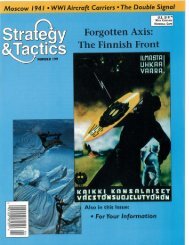COUNTERSTROKE AT SOLTSY - Strategy & Tactics Press
COUNTERSTROKE AT SOLTSY - Strategy & Tactics Press
COUNTERSTROKE AT SOLTSY - Strategy & Tactics Press
Create successful ePaper yourself
Turn your PDF publications into a flip-book with our unique Google optimized e-Paper software.
The method of mine countermeasures<br />
used in any one place is always<br />
determined by the type of mine<br />
encountered. Moored mines can be<br />
swept by gear towed behind minesweepers.<br />
Once such mines’ mooring<br />
cables are cut, they float to the<br />
surface where they can be destroyed<br />
by gunfire. Bottom influence mines,<br />
however, particularly those that try<br />
to defeat influence sweeping through<br />
the use of a counter-countermeasure,<br />
are more difficult to defeat. Influence<br />
sweeping requires the sweeper to tow<br />
a system behind it that simulates the<br />
various influences ships impart on<br />
their environment. The intent is to<br />
detonate the mines at a safe distance<br />
behind the sweeper.<br />
Without foreknowledge of the<br />
mines’ type (magnetic, magneticacoustic,<br />
pressure, etc), the commander<br />
must simulate all the influences<br />
the mines may be targeting. By the<br />
1970s, some mines could also be set<br />
for specific target types (for example,<br />
cruisers or aircraft carriers instead of<br />
destroyers), further complicating the<br />
mine countermeasure problem.<br />
Mines with counter-countermeasures<br />
allowed a pre-set number of<br />
targets to pass before detonating.<br />
Others had pre-set activation and deactivation<br />
dates, either to ensure safe<br />
passage during set periods, establish<br />
a “sanitation date,” or just to further<br />
complicate the mine countermeasures<br />
problem. Defeating those mines<br />
necessitated extensive sweeping for<br />
several weeks just to provide a probability,<br />
not certainty, of safe passage.<br />
Worse, since pressure mines relied on<br />
the level of pressure engendered by<br />
a ship’s passage through the water,<br />
phenomena that varied according to a<br />
ship’s size and speed, they could not<br />
be fooled by simulation devices. They<br />
could only be detonated through the<br />
use of a specially designed ship of the<br />
size and type that generated both the<br />
required “pressure wave” and had the<br />
reinforced hull and systems to survive<br />
the blast. Ultimately, the problems of<br />
defeating pressure mines led to the<br />
development of mine hunting.<br />
Mine hunting is even slower than<br />
minesweeping and was, in its early<br />
days, far more dangerous. Though sonar<br />
and other sensors can detect bottom<br />
mines, those systems also detect<br />
a large number of non-mine objects<br />
with similar shapes and dimensions.<br />
Further, tides, marine life and bottom<br />
materials tend to obscure mines over<br />
time. Hence every suspected mine has<br />
to be investigated individually. Some<br />
mines have anti-diver devices, either<br />
attached or placed nearby, which<br />
detonate when any small metallic<br />
object remains near it for a set time.<br />
All the dangers involved led<br />
Western nations to develop and rely<br />
increasingly on methods that didn’t<br />
require divers. The American use of<br />
dolphins in Vietnam and the Persian<br />
Gulf was a controversial solution.<br />
Most Western nations relied on<br />
remote underwater robotic systems as<br />
the Cold War drew to an end, as does<br />
the US today.<br />
Mine warfare figured prominently<br />
in four of the hot wars that occurred<br />
during the Cold War: Korea, Vietnam,<br />
the 1967 Arab-Israeli War, and the<br />
Iraq-Iran War. Ironically, World War<br />
I-era moored contact mines dominated<br />
the minefields of all but the second<br />
of those conflicts. The US Navy was<br />
also embarrassed by its lack of mine<br />
countermeasures forces in three of<br />
those wars, and only avoided such<br />
embarrassment again in Vietnam<br />
because the North Vietnamese didn’t<br />
employ mines to any significant<br />
degree.<br />
The US encountered few mines<br />
during the early naval operations of<br />
the Korean War. Expecting a short<br />
war and seeing little risk of US<br />
involvement, North Korea saw little<br />
need for protective minefields when<br />
its troops invaded South Korea in<br />
1950. Then Gen. MacArthur’s landing<br />
at Inchon changed Pyongyang’s<br />
strategic thinking. China’s leaders<br />
were also aware of the US Navy’s<br />
amphibious capabilities, and they<br />
therefore emphasized the use of<br />
mines in coastal defense operations.<br />
The two allies laid thousands of<br />
Soviet-supplied naval mines off North<br />
Korea’s coast in 1950-51, placing<br />
the largest concentrations around the<br />
country’s eastern ports. With almost<br />
all of America’s mine countermeasures<br />
units having been decommissioned<br />
after World War II, the USN<br />
had to reactivate Imperial Japanese<br />
Navy mine sweeping units, including<br />
their crews, to sweep the thousands of<br />
moored contact mines encountered off<br />
Wonsan and Hangnam harbors. That<br />
embarrassment rejuvenated America’s<br />
mine warfare consciousness and<br />
efforts in the 1950s, but those new<br />
forces were placed in reserve by the<br />
early 1960s.<br />
The 1967 Arab-Israeli War saw<br />
the next significant employment of<br />
naval mines when Egypt closed the<br />
Suez Canal and the Israeli port of<br />
Eilat by laying thousands of mines<br />
in and around their approaches. The<br />
Egyptians sprinkled bottom influence<br />
magnetic mines among the moored<br />
contact mines in their minefields.<br />
Though the minefields didn’t affect<br />
operations by the Israeli Navy’s<br />
smaller combatants, it prevented their<br />
destroyers and transports from using<br />
those waters. It also deterred merchant<br />
shipping from entering Eilat.<br />
Fortunately for Israel, the fields off<br />
Eilat contained a manageable number<br />
of mines. The moored contact mines<br />
were cleared in a few days, but it took<br />
several months of mine hunting by<br />
divers to clear away the bottom influence<br />
mines.<br />
It was the US that employed naval<br />
mines in the largest numbers and to<br />
the greatest effect during the Vietnam<br />
War. The Viet Cong occasionally used<br />
floating mines in South Vietnam’s<br />
rivers, and the North Vietnamese<br />
employed a few moored contract<br />
mines on an ad hoc basis. The US,<br />
however, used aircraft-dropped mines<br />
to close North Vietnam’s Haiphong<br />
Harbor and other ports to shipping.<br />
Equipped with a variety of sensor and<br />
counter systems, those mines proved<br />
far beyond North Vietnam’s ability to<br />
sweep, closing the ports completely<br />
to shipping. The impact of those<br />
closures contributed to bringing North<br />
Vietnam to the negotiating table,<br />
and the agreement that ended that<br />
war included a requirement for the<br />
US to clear the minefields, a process<br />
that took over two months. A few<br />
months later, those same USN mine<br />
countermeasures units joined with<br />
Egyptian forces to conduct the mine<br />
clearing effort that allowed the Suez<br />
Canal to be reopened after eight years<br />
of closure. As the 1980s approached,<br />
however, the US refocused its naval<br />
forces on open ocean operations and<br />
left mine countermeasures to its allies.<br />
Iran employed mines surreptitiously<br />
during its war with Iraq in the<br />
1980s. Since laying mines in international<br />
waters violated international<br />
law, Iran conducted its operations<br />
covertly, using nominally civilian surface<br />
craft to lay moored contact mines<br />
in the Persian Gulf’s shipping lanes.<br />
strategy & tactics 35







